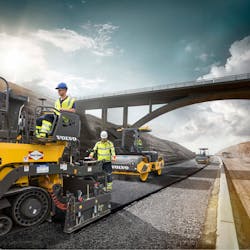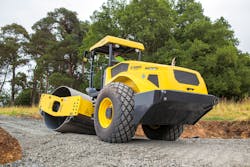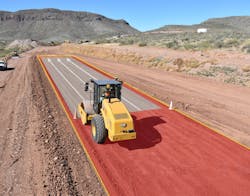Regardless of hype that may accompany a new product release, it is performance over the test of time that will always win out as the benchmark of quality. For roadwork, quality is paramount; nothing equals the headache of having to re-do a job poorly executed with failing materials.
Bert Erdman, BOMAG product manager of heavy compaction, speaks to this dilemma as "a problem solved by our sophisticated sensors that offer intelligent compacting."
“A lot of our commercial customers on the asphalt side really appreciate how BOMAG machines deliver quality assurance on the job with consistent rolled patterns,” he says.
Erdman adds that operators are flying blind in the dark, as it takes years of experience to know "the right feel" of perfectly compacted surfaces.
“This nuanced technique of perfection requires considerable machine time to acquire, but with our latest mapping tool BOMAP, launched at ConExpo, an operator with virtually no training can turn on the machine and deliver a perfect surface.
“The intelligent compacting uses proprietary sensors that we have developed in Germany for use worldwide. They work by giving the operator a readout of stiffness values and matching it with the temperature on the asphalt since the cooling asphalt must be compacted at a lower temperature. If this is not accounted for, any excessive vibrating will crush the aggregate. There is no question as to the value this affords your project."
He says that the sensors also detect if you have a weak spot on the job site.
"Sometimes you can't get the density you need; it might be a bad subgrade for example. But nobody wants to come back later when it fails and have to dig it up and fix it. With this tool, you can detect it on the spot and amend the problem while you are doing the project.
“These sensors benefit any compacting and there is no limit where you can use them: on a base layer, on a new overlay, or on a finish layer. You get the proper density established from the get-go and the algorithm calculates all the variables against your input values for guaranteed consistency. It's foolproof."
Erdman also describes the benefits of the BOMAG hybrid technology that not only saves fuel but is aligned with the green economy goals.
"In 2019 we introduced a hybrid drive system that reduces CO2 emissions by 20%. On the BW 174AP Hybrid, operators have the same power and performance they are used to having with a conventional drive system."
Erdman explains that the innovative BOMAG hybrid system uses a Kubota engine with rail injection and its hybrid accumulator covers peak loads by balancing the 100 Nm and 20kW of power directly onto the crankshaft.
“This gives the machine a total of 75kW which is equal to the conventional drive system. And the storage is charged in overrun mode, so, in just a few seconds it is recovering energy, (instead of using fuel) and this happens so fast the driver isn’t even aware it’s taking place.”
“When this system is paired with our Asphalt Manager compaction system, you can accelerate from a standstill, which is the benefit of electric power: energy is immediately available. And our Asphalt Manager is unique to the market as it delivers absolute precision with infinitely variable compaction force control making fewer passes necessary.”
With machines making fewer passes to achieve that perfect surface in density, Erdman says this translates to less overall fuel, less noise, and an overall compaction force that exceeds conventional vibratory systems by 20%. In a field test of BOMAG hybrid machines deployed worldwide, these savings were confirmed by tracking real-time usages.
"The next step is an all-electric model and with the innovations in battery capacity development—which until recently has been the limiting factor for this market—we've already developed our all-electric prototype.
What we were hearing from contractors at the big meetings was that they wish they had electric-powered units for their indoor jobs. If you are paving a large parking garage, and compacting before you pour, especially in a climate where temperatures require working in a closed space, the last thing you want is to put operators at risk.
Finally, Erdman says their research technology has brought construction machinery to a fully autonomous operation with ROBOMAG tandem roller.
“The ROBOMAG is a fully remote-controlled operation using GPS, Lidar, and our sophisticated sensor to perform a rolling job totally operator-free. The tandem roller is equipped with the Asphalt Manager so you get the compaction performance plus capability for the remote operation that will perform based on your system inputs. With its environmental perception recognition system, collisions are prevented and a mechanical stop mechanism is built into each mode for any emergency.
“This is a safe and environmentally desirable machine that will revolutionize the job site, especially for those site situations that are particularly high-risk for machine and operators.”
A Command Performance
According to Caterpillar’s global sales consultant Dave Gerding, “We’ve launched two big updates to the CS56B, as well as our other B Series vibratory soil compactors.”
He says that they have recently announced a rear vision camera “which is a standard feature, while our Command for Compaction technology is a new option.
“The new rear-vision camera gives operators a better field of vision behind the machine. At the same time, this helps reduce operator fatigue as you don’t have to keep turning around to look over your shoulder and see what’s behind you when you are in reverse mode.
“Our Cat Command Compaction is a really exciting technology as well. This can now be added to your existing equipment and it automates the compaction process so you can get consistent and predictable compaction results.”
“The operator defines the boundary to be compacted by physically recording it with the machine and then gives the system three inputs. The first one is the number of passes, then ground speed, then overlap.
“After these inputs are entered, the operator puts the machine in Auto mode. Then, the Command for Compaction takes over and controls the machine speed, direction, steering, and vibration. Essentially, the machine will execute the compaction under the specific parameters you entered. So now, rather than being an operator with the often frustrating task of getting all the variables right under different conditions, the operator becomes more of a compaction process and safety monitor,” says Gerding.
The auto mode can be stopped at any point for the operator to take over and work in the traditional manual mode if the need arises. Gerding emphasizes that one of the biggest benefits of the Command for Compaction is its capability to improve coverage in the overlap.
"When the machine is controlling the overlap, we've seen as much as a 60% increase in coverage when compared to the coverage done by a novice operator. The critical factor here is that a well-executed surface can be the difference between passing an onsite compaction test or not."
Gerding explains that most contractors will put their newest or less experienced operators on soil compaction and will often rotate multiple operators on the shift to get that area done.
“But this leaves a lot of room for inconsistencies in compaction; three people trying to do the same job creates inconsistent results. Here's where the Command for Compaction eliminates any guesswork. You put the parameters in the machine and it does the work against those requirements regardless of the operator. And with fewer skilled operators available, and many of the skilled guys retiring now, this shrinking job pool dictates it will be even more crucial for contractors to turn to technology to achieve desired results."
Gerding explains that the Command for Compaction technology had a limited launch in early 2020 but he adds, “By August of this year the optional semi-autonomous technology will be available on many more models in the US and Canada. These will include CS56B, our CP 56B, the CS68B, CP68B, both our CS74B and CP74B, and the CS 78B.
Also, he says the rear-vision camera with color touchscreen display is standard on all those models “plus our CS45, CP34, CS44B, the CP44B and both the CS and CP54B models.”
"It's so easy to set up and it's easy to use and there are no intimidating site design files or back-office work needed. Our system connects to commonly used base stations that many contractors are already using to run their grading machines.
“So, what the compacting operator does is define the area to be compacted by physically using the machine to record it. Then, using those three inputs the operation becomes simple and intuitive."
Along with performance and consistency, these technologies also contribute to job safety.
For example, "If something gets in front of or behind the machine, the built-in object detection system sends visual and audible alerts so the operator can stop the machine.
“Safe, efficient, and with predictable quality outcomes—the perfect trio for any project!”
An Even Better Drumroll, Please!
Compaction product manager Mark Eckert at Volvo Construction Equipment observes that, while “Dual amplitude drums remain common in the industry, the machines with more amplitude selections offer you the capability for superior results. And our amplitude technology is indeed praiseworthy.
“The newest C-series double-drum compactors from Volvo combine high centrifugal force and up to eight amplitude settings. This versatility gives road crews more options to handle different types of lift and mix characteristics so you can achieve your target density more quickly.
"In an industry that typically works on narrow margins, having consistent speed and quality compaction are essential, and our machines help you get there.”
Eckert says the new Volvo DD128C asphalt compactor is one of their largest models and “is our most technologically advanced from both a hardware and software perspective.
"It's bringing you the highest frequency on the market at 4800 VPM so operators can roll quickly while maintaining the proper impact spacing giving you the most productive rolling train available."
He says that the wide range of amplitudes—from 0.00–30.03 inches, or 0.08–0.8 millimeters—gives operators unmatched versatility.
"Whether the job is an ultra-thin lift, deep lift, tender or harsh mix, the technology detects amplitude setting, and vibration frequency is automatically adjusted to the highest VPM available for that amplitude. So, operators can get the highest rolling speeds and best productivity without compromise.”
The amplitude sensing technology uses an accelerometer and takes amplitude measurements on each drum. “This automatically adjusts the frequency and once it has been adjusted for each drum, the vibration frequency is automatically set at optimum VPM.
“For example, on the DD128C model, the setting one (of eight) is at 4800 VPM which is about 600 VPMs higher than any other manufacturer."
Describing the drum, Eckert says the DD128C features a 79-inch (2000mm) wide drum with chamfer and radii drum edges and also a large 55-inch (1400-millimeter) diameter drum. These also feature auto-reversing eccentricities "which are an automatic function that ensures eccentric rotation in the direction the machine is traveling, giving you unparalleled smoothness in your compaction.”
Equipped with an industry-leading automatic drum wetting system Eckert says, “The water flow being dispensed is speed-dependent which minimizes water usage and ensures uniform drum coverage to prevent material pick-up."
"Our large asphalt compactors are powered by the high torque, low rpm Volvo D4 Tier 4 Final engine. This delivers high-quality performance with minimal noise. Plus, its optional auto-idling and auto engine shutdown features also help enhance fuel efficiency.”
One of the software features that further assists operators is Compact Assist, part of the Volvo Intelligent Compaction System which gives operators real-time feedback on compaction status.
“This helps maximize your productivity,” says Eckert, and he explains the process.
“Our Co-Pilot display gives you pass mapping and temperature mapping and Density Direct displays an estimate of the density of the mat in real-time. This increases the operator's confidence that targets are being met and eliminates the guesswork.
“Then, all the data is recorded and saved on the Co-Pilot platform which can be downloaded manually or uploaded to a cloud. This documentation can serve as evidence demonstrating your job project performance."
Eckert adds that the Care Track Telematics system which comes standard on new asphalt compactors with electric engines is another software advantage.
“Road crews are never on their own with CareTrack. This system can remotely access a range of important compaction information including geolocation, fault codes, service, and maintenance planning.
"Out in the field, a contractor will be alerted if an engine is running at too high of a temperature, for example. These types of notifications can call attention to a problem early and prevent machines from becoming disabled, and this early warning system averts the costs in downtime and labor for a repair.”
Safety and uncomplicated maintenance are other equally outstanding assets of the Volvo C-series, Eckert affirms.
“We’ve designed the machines for unobstructed visibility, unobstructed sightline, and ergonomically designed seats and controls for operators.”
Helping operators work with less strain resulted in their developing the reclining seatback which is standard on the DD110C through the DD 140C.
“This helps operators who typically are in a 90-degree position and are trying to line up to a curb or outer edge. They have to lean out to gauge position, which is neither safe nor comfortable, and doing this all day is wearing. And when you are uncomfortable you are distracted and you lose your focus,” Eckert explains.
He adds that for maintenance they have one single key that will open all the service doors and the intelligently designed swing-up hood allows for unobstructed access to the engine and hydraulic components.
“Volvo is constantly listening to customer feedback and our company development team consistently works toward solutions to make the on-the-job experience efficient, profitable, and operator-friendly," says Eckart.











